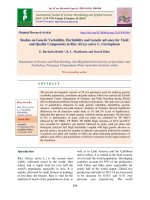Correlation and path analysis for yield and yield components in Blackgram [Vigna mungo (L.) Hepper]
Bạn đang xem bản rút gọn của tài liệu. Xem và tải ngay bản đầy đủ của tài liệu tại đây (283.53 KB, 11 trang )
Int.J.Curr.Microbiol.App.Sci (2018) 7(7): 2074-2084
International Journal of Current Microbiology and Applied Sciences
ISSN: 2319-7706 Volume 7 Number 07 (2018)
Journal homepage:
Original Research Article
/>
Correlation and Path Analysis for Yield and Yield Components
in Blackgram [Vigna mungo (L.) Hepper]
Ranjeet A. Tambe*, Gabrial M. Lal, and Pramod W. Ramteke
Department of Genetics and Plant Breeding, Naini Agriculture Institute,
Sam Higginbottom University of Agriculture, Technology and Sciences,
Allahabad-211007 (U.P.), India.
*Corresponding author
ABSTRACT
Keywords
Black gram
[Vignamungo (L.)
Hepper], Genetic
variability,
correlation, Path
analysis
Article Info
Accepted:
15 June 2018
Available Online:
10 July 2018
The experimental material was consisting of 41 Black gram genotypes, check as T-9,
during kharif 2017. The experiment was laid out in Randomised Complete Block Design
with 3 replications at field experimentation centre of Department of Genetics and Plant
Breeding, Sam Higginbottom University of Agriculture, Technology & Sciences. The
observations were logged on five randomly taken plants to each treatment and replication
for 13 quantitative characters viz. days to 50% flowering, days to 50% pod setting, plant
height, number of primary branches per plant, clusters per plant, pods per plant, pod
length, seeds per pod, days to maturity, seed index, biological yield, harvest index and seed
yield to estimate the variability, heritability and genetic advance as % mean, character
association and path analysis. High heritability along with high Genetic advance as %
mean was observed for harvest index and seed yield per plant represents simple selection
is effective to improve these characters. The correlations revealed that harvest index, seeds
per pod , days to 50% pod setting, pods per plant, days to 50 % flowering, seed index and
biological yield have the significant positive association with the seed yield per plant at
both genotypic and phenotypic levels. The path analysis revealed that the harvest index,
biological yield, days to 50 % flowering, plant height, pod length and clusters per plant
had shown the true relationship with seed yield by establishing the positive correlations
and direct effects at both genotypic and phenotypic levels, while branches per plant and
days to maturity at genotypic levels and pods per plant and seeds per pod at phenotypic
levels.
Introduction
Blackgram [Vigna mungo (L.) Hepper],
Chromosome number 2n=22, is a selfpollinating and widely cultivated grain
legume. It is one of the most important pulse
crops grown in India. The cultivated
blackgram
belongs
to
the
family
Leguminosae, sub-family Papilionaceae. It is
mainly a day neutral warm season crop
commonly grown in semi-arid to sub-humid
low land tropics and sub-tropics. This crop is
grown in cropping systems as a mixed crop,
cash crop, sequential crop besides growing as
2074
Int.J.Curr.Microbiol.App.Sci (2018) 7(7): 2074-2084
sole crop under residual moisture conditions
after the harvest of rice and also before and
after the harvest of other summer crops under
semi irrigated and dry land conditions
(Parveen et al., 2011).
knowledge of genetic variability for characters
of economic importance and their heritability
and genetic advance is of utmost importance
in planning future breeding programme (Singh
et al., 2007).
Variability refers to the presence of
differences among the individuals of plant
population.Itresultsduetodifferenceeitherinthe
geneticconstitutionoftheindividualof
a
population or the environment they have
grown. The existence of variability is essential
for improvement of genetic material. The
study of genetic variability in any crop would
help in the genetic improvement of yield and
desirable characters. It will facilitate the
identification of proper genotypes for a
particular
agro-climate.
Identification,
characterization and study of genotypes and
genetic homology between them would
provideabaseforfurtherstudiesforcropimprove
ment.Theobservedphenotypicvariation is the
result of an interaction between genotype and
environment in which the individuals are
grown. However, it is only genetic variation
which is heritable and hence important in any
selection programme.
Seed yield is a complex trait and is influenced
by number of component traits. The study on
inter-relationship between the component
traits and seed yield will formulate an
effective and viable breeding programme for
improvement of yield in a short time. Studies
on correlation values indicate the intensity and
direction of association of a character with
yield. Path analysis identifies the yield
components with direct and indirect influence
on the yield. Hence, the present research work
was undertaken to assess the correlation and
path coefficients estimates of economically
important plant characteristics and to
determine the characteristics contributing to
seed yield in blackgram (Patidar and Sharma,
2017).
Grain yield is complex character, which
depends on its main components viz; number
of pod per plant, pod length, number of seed
per pod and 100 seed weight. These
components are further dependent for their
expression on several morphological and
developmental traits, which are interrelated
with each other and therefore, the parent
selected for the breeding programmes aimed at
increased seed yield should possess wide
range of genetic variation for the above said
morphological and developmental characters.
Besides, it could be of interest to know the
magnitude of variation due to heritable
component, which in turn would be a guide
for selection for the improvement of a
population. In other words, for the
improvement in any crop species, the
In view of these facts, 41 blackgram
genotypes were evaluated in this study to
estimate genetic variability, correlation
coefficient and direct and indirect effect of
yield and yield components on grain yield to
screen out the suitable genotype for
exploitation in a breeding programme aimed at
improving grain yield potential of blackgram.
Materials and Methods
The present investigation was carried out at
the Field Experimentation Centre, Department
of Genetics and Plant Breeding, Naini
Agricultural Institute, Sam Higginbottom
University of Agriculture, Technology and
Sciences, Allahabad, U.P. (India) during
Kharif-2017.The
experimental
materials
constituted of the germplasm collection of 41
genotypes of Black gram [Vigna mungo (L)
Hepper], procured from Department of
Agriculture Botany, Dr.Punjabrao Deshmukh
2075
Int.J.Curr.Microbiol.App.Sci (2018) 7(7): 2074-2084
Krishi Vidyapeeth, Akola, (Maharashtra).
Data were recorded from five randomly
selected plants from each genotype per
replication and the average was taken for
analysis. All the recommended package of
practices was followed to raise a good crop.
The experiment was laid out in Randomised
Complete Block Design with 3 replications.
The genotypes were sown by hand dibbling in
each plot by imposing randomisation in each
replication along with check T-9. Each plot
has 4 rows with the spacing of row to row
30cm and plant to plant 10 cm. Standard
statistical procedures were used for the
analysis of correlation coefficient values(r) at
genotypic and phenotypic levels by Johnson et
al., (1955) and described by Singh and
Choudhary (1985).
Path coefficient analysis was utilized to
partition the phenotypic and genotypic
correlation coefficient into the direct effects
and indirect effects along with residual effects.
The analysis was carried out as per the
equation suggested by Dewey and Lu (1959)
originally proposed by Wright (1921) and
described by Singh and Choudhary (1985).
Results and Discussion
The analysis of variance revealed highly
significant to significant differences among
the genotypes for all the thirteen characters
studied (Table 1). In the present study,
variation among the characters is estimated by
Genotypic Coefficient of Variation (GCV) and
Phenotypic Coefficient of Variation (PCV).
The PCV was higher than the GCV for few
characters indicates the interaction of
genotypes with the environment (Table 2).
High GCV and PCV were recorded for harvest
index (20.52 and 21.86) followed by seed
yield /plant (18.67 and 19.89), clusters per
plant (15.40 and 17.12) and biological yield
(14.26 and 14.43).
Estimates of heritability are a good index for
predicting the transmission of characters from
parents to their offspring (Falconer, 1981).
High heritability (broad sense) was recorded
for characters i.e., biological yield per plant
(97.68%), followed by days to 50% flowering
(95.75%),days to 50% pod setting (94.66%),
plant height (94.55%),pods per plant
(93.76%), harvest index (88.15%), seeds per
plant (88.11%). High heritability alone may
not lead to valid conclusions unless it is
accompanied with the Genetic advance as
percent mean (Johnson and Robinson, 1955).
High heritability coupled with high genetic
advance as percent of the mean was recorded
for harvest index, seed yield per plant and
biological yield. These findings are in
accordance with Rajashekhar et al., (2017)
and Rolaniya et al., (2017).
The genotypic and phenotypic correlation
coefficients were computed among 13
characters (Table 3). The correlations revealed
that harvest index, seeds per pod ,days to 50%
pod setting, pods per plant, days to 50 %
flowering, seed index and biological yield
have the significant positive association with
the seed yield per plant at both genotypic and
phenotypic levels, while pod length and plant
height showing negative but significant
association with seed yield at both genotypic
as well as phenotypic level. Similar result
found Babu et al., (2016) Therefore, these
characters appeared as greatest important
associates of seed yield per plant and have
also been observed by preceding workers
(Sushmitharaj et al., 2018; Hemalatha et al.,
2017, Hemavathy et al., 2015).
The correlation values provided only nature
and degree of relationship of yield
contributing characters on seed yield. Path
coefficient analysis is a statistical technique to
split the observed correlation coefficients into
direct and indirect effects of independent
variables on the dependent variable. In the
2076
Int.J.Curr.Microbiol.App.Sci (2018) 7(7): 2074-2084
present study, path coefficient analysis was
carried out using genotypic and phenotypic
correlation matrix of 13 characters (table 5).
The path analysis revealed that the harvest
index, biological yield, days to 50 %
flowering, plant height, pod length and
clusters per plant had shown the true
relationship with seed yield by establishing the
positive correlations and direct effects at both
genotypic and phenotypic levels, while
branches per plant and days to maturity at
genotypic levels and pods per plant and seeds
per pod at phenotypic levels. These results
were in accordance with the findings of Bharti
et al., (2013), Kanimoli et al., (2015) and
Patidar and Sharma (2017). By considering
the nature and extent of correlation
coefficients and their direct and indirect
effects it can be concluded that improvement
of Black gram seed yield is brought through
simultaneous selection seeds per pod,pod per
plant, biological yield and harvest index.
Table.1 Analysis of variance for different characters of Black gram
S. No.
Parameters
Mean Sum of Squares
Replications
Genotypes
Error
(df = 2)
(df = 40)
(df = 80)
1
Days to 50% Flowering
0.1707
40.9000**
0.5957
2
Days to 50% Pod Setting
0.1545
42.7073**
0.7878
3
Plant Height (cm)
0.1729
102.4780**
1.9295
4
Branches/ Plant
0.4315
0.2271*
0.1469
5
Clusters/ Plant
0.0315
5.7850**
0.4205
6
Pods/ Plant
0.0452
33.2665**
0.7215
7
Pod Length (cm)
0.2518
0.3487**
0.0820
8
Seeds/ Pod
0.0296
0.7776**
0.3023
9
Days to Maturity
2.2520
27.8175**
1.3187
10
Seed Index (g)
0.1642
1.2499**
0.0600
11
Seed Yield/ Plant (g)
0.1876
8.1714**
0.3517
12
Biological Yield (g)
1.7044
191.2677**
1.4959
13
Harvest Index (%)
0.2681
32.8512**
1.4083
*&** Significant at 5%& 1% level of significant respectively
2077
Int.J.Curr.Microbiol.App.Sci (2018) 7(7): 2074-2084
Table.2 Genetic parameter of different characters in Blackgram
S.NO
1
2
3
4
5
6
7
8
9
10
11
12
13
Character
Days to 50% Flowering
Days to 50% Pod Setting
Plant Height (cm)
Branches/ Plant
Clusters/ Plant
Pods/ Plant
Pod Length (cm)
Seeds/ Pod
Days to Maturity
Seed Index (g)
Seed Yield/ Plant (g)
Biological Yield (g)
Harvest Index (%)
VG
VP
13.43
13.97
33.52
0.03
1.79
10.85
0.09
0.16
8.83
0.40
2.61
63.26
10.48
14.03
14.76
35.45
0.17
2.21
11.57
0.17
0.46
10.15
0.46
2.96
64.75
11.89
GCV
(%)
9.65
7.65
10.70
6.75
15.40
9.86
6.83
7.89
4.38
12.72
18.67
14.26
20.52
2078
PCV
(%)
9.86
7.86
11.01
17.20
17.12
10.19
9.46
13.45
4.70
13.65
19.89
14.43
21.86
h2bs
%
95.75
94.66
94.55
15.39
80.95
93.76
52.02
34.39
87.00
87.86
88.11
97.68
88.15
GA
7.39
7.49
11.60
0.13
2.48
6.57
0.44
0.48
5.71
1.21
3.12
16.19
6.26
GA as % mean
19.44
15.32
21.44
5.45
28.55
19.67
10.14
9.53
8.42
24.43
36.10
29.04
39.69
Int.J.Curr.Microbiol.App.Sci (2018) 7(7): 2074-2084
Table.3 Correlation coefficient between yield and its related traits in 41Blackgram genotypes at Genotypic level
No
Character
1
Days to 50% Flowering
2
3
Days to 50% Pod
Setting
Plant Height
4
Branches/ Plant
5
Clusters/ Plant
6
Pods/ Plant
7
Pod Length
8
Seeds/ Pod
9
Days to Maturity
10
Seed Index
11
Biological Yield
12
Harvest Index
13
Seed Yield/ Plant
Days to
50%
Flowerin
1.00
Days to
50% Pod
Setting
0.933**
1.00
Plant
Height
Branches/
Plant
Clusters/
Plant
Pods/
Plant
Pod
Length
Seeds/
Pod
Days to
Maturity
Seed
Index
-0.073
-0.298**
-0.157*
-0.012
-0.472**
-0.164*
-0.118
-0.174*
0.055
-0.415**
1.00
0.089
-0.182*
-0.267**
0.249**
0.021
1.00
0.092
0.026
0.424**
0.253**
1.00
0.443**
0.165*
0.169*
1.00
0.031
1.00
Biological
Yield
harvest
Index
-0.084
0.753**
0.580**
-0.103
0.293**
Seed
Yield/
Plant
0.285**
0.002
0.798**
0.572**
-0.120
0.382**
0.359**
0.013
0.152
0.133
-0.275**
-0.201*
-0.104
-0.064
0.137
-0.102
-0.023
-0.108
-0.274**
-0.079
0.222*
0.207*
-0.414**
-0.062
-0.044
0.191*
0.152
0.345**
-0.221*
-0.105
-0.165*
0.014
-0.332**
-0.365**
1.00
0.004
-0.190*
-0.041
0.519**
0.572**
1.00
0.494**
-0.159*
0.207*
0.133
1.00
-0.029
0.272**
0.261**
1.00
-0.528**
0.196*
1.00
0.723**
1.00
*&** Significant at 1% and 5% level of significance respectively
2079
Int.J.Curr.Microbiol.App.Sci (2018) 7(7): 2074-2084
7
Pod Length (cm)
8
Seeds/ Pod
9
Days to Maturity
10
Seed Index (g)
11
Biological Yield (g)
12
harvest Index (%)
13
Seed Yield/ Plant (g)
Seed Yield/
Plant (g)
Pods/ Plant
harvest
Index (%)
6
Biological
Yield (g)
Clusters/ Plant
Seed Index
(g)
5
Days to
Maturity
Branches/ Plant
Seeds/ Pod
4
-0.073
-0.098
-0.133
-0.017
-0.337**
-0.012
0.689**
0.514**
-0.107
0.266**
0.254**
1.00
-0.147
-0.052
-0.152
0.060
-0.283**
-0.024
0.730**
0.536**
-0.111
0.347**
0.331**
1.00
0.042
-0.169*
-0.238**
0.186*
0.031
0.020
0.144
0.130
-0.240**
-0.172*
1.00
0.057
-0.008
0.159*
-0.008
-0.063
-0.007
0.047
-0.016
0.001
1.00
0.403**
0.122
0.057
-0.077
-0.220*
-0.061
0.134
0.126
1.00
0.001
-0.266**
-0.048
-0.024
0.188*
0.137
0.315**
1.00
-0.078
-0.083
-0.089
0.028
-0.242**
-0.249**
1.00
0.001
-0.144
-0.029
0.310**
0.335**
1.00
0.429**
-0.142
0.176*
0.112
1.00
-0.018
0.237**
0.233**
1.00
-0.505**
0.183*
1.00
0.748**
Pod Length
(cm)
Plant Height (cm)
0.888**
Pods/ Plant
3
Clusters/
Plant
Days to 50% Pod Setting
Branches/
Plant
2
1.00
Plant Height
(cm)
Days to 50% Flowering
Days to
50% Pod
Setting
Character
1
Days to
50%
Flowering
S. No
Table.4 Correlation coefficient between yield and its related traits in 41blackgram genotypes at phenotypic level
1.00
*&** Significant at 1% and 5% level of significance respectively
2080
Int.J.Curr.Microbiol.App.Sci (2018) 7(7): 2074-2084
Plant
Height (cm)
Branches/
Plant
Clusters/
Plant
Pods/ Plant
Pod Length
(cm)
Seeds/ Pod
Days to
Maturity
Seed Index
(g)
Biological
Yield (g)
harvest
Index (%)
0.1856
-0.0145
-0.0593
-0.0312
-0.0024
-0.0939
-0.0167
0.1499
0.1154
-0.0206
0.0583 0.2849**
2 Days to 50% Pod
Setting
-0.1647
-0.1764
0.0288
0.0208
0.0308
-0.0098
0.0732
-0.0004
-0.1408
-0.1010
0.0211
-0.0674 0.3586**
3 Plant Height (cm)
-0.0022
-0.0050
0.0307
0.0027
-0.0056
-0.0082
0.0076
0.0007
0.0004
0.0047
0.0041
-0.0084 -0.2006*
4 Branches/ Plant
-0.0163
-0.0065
0.0049
0.0547
0.0051
0.0014
0.0232
0.0138
-0.0057
-0.0035
0.0075
-0.0056
-0.0227
5 Clusters/ Plant
-0.0003
-0.0003
-0.0003
0.0002
0.0018
0.0008
0.0003
0.0003
-0.0002
-0.0005
-0.0001
0.0004
0.2072*
6 Pods/ Plant
0.0008
-0.0038
0.0183
-0.0018
-0.0304
-0.0687
-0.0022
0.0284
0.0043
0.0030
-0.0131
-0.0104 0.3448**
7 Pod Length (cm)
-0.0036
-0.0032
0.0019
0.0033
0.0013
0.0002
0.0077
-0.0017
-0.0008
-0.0013
0.0001
-0.0025 -0.3653**
8 Seeds/ Pod
0.0112
-0.0003
-0.0029
-0.0338
-0.0226
0.0553
0.0296
-0.1337
-0.0005
0.0254
0.0055
-0.0694 0.5723**
9 Days to Maturity
0.0516
0.0547
0.0009
-0.0072
-0.0074
-0.0043
-0.0072
0.0003
0.0685
0.0338
-0.0109
0.0142
10 Seed Index (g)
-0.0873
-0.0861
-0.0229
0.0096
0.0412
0.0067
0.0247
0.0286
-0.0742
-0.1504
0.0043
-0.0408 0.2611**
11 Biological Yield (g)
-0.0930
-0.1076
0.1200
0.1230
-0.0709
0.1721
0.0128
-0.0370
-0.1427
-0.0257
0.8994
-0.4747
12 harvest Index (%)
0.3897
0.5076
-0.3656
-0.1350
0.2953
0.2016
-0.4412
0.6898
0.2747
0.3610
-0.7015
1.3291 0.7227**
Bold are direct effects, R SQUARE = 0.9898, RESIDUAL EFFECT = 0.1012.
2081
Seed Yield/
Plant (g)
Days to
50% Pod
Setting
0.1989
Character
1 Days to 50% Flowering
No
Days to
50%
Flowering
Table.5 Direct and indirect effects between yield and its related traits in 41Blackgram genotypes at genotypic level
0.1328
0.1958*
Int.J.Curr.Microbiol.App.Sci (2018) 7(7): 2074-2084
Table.6 Direct and indirect effects between yield and its related traits in 41Blackgram genotypes at phenotypic level
No
Character
Days to
50%
Flowering
Days to
50%
Pod
Setting
Plant
Height
(cm)
Branche
s/ Plant
Clusters
/ Plant
Pods/
Plant
Pod
Length
(cm)
1 Days to 50%
Flowering
0.0834
2 Days to 50% Pod
Setting
Seed
Index
(g)
Biologic
al Yield
(g)
harvest
Index
(%)
0.0741
-0.0061
-0.0082
-0.0111
-0.0014
-0.0281
-0.0010
0.0575
0.0428
-0.0089
0.0222
0.2538**
-0.0101
-0.0114
0.0017
0.0006
0.0017
-0.0007
0.0032
0.0003
-0.0083
-0.0061
0.0013
-0.0040
0.3311**
3 Plant Height (cm)
-0.0012
-0.0023
0.0157
0.0007
-0.0027
-0.0037
0.0029
0.0005
0.0003
0.0023
0.0020
-0.0038
-0.1721*
4 Branches/ Plant
0.0012
0.0007
-0.0005
-0.0127
-0.0007
0.0001
-0.0020
0.0001
0.0008
0.0001
-0.0006
0.0002
0.0014
5 Clusters/ Plant
-0.0014
-0.0016
-0.0018
0.0006
0.0108
0.0043
0.0013
0.0006
-0.0008
-0.0024
-0.0007
0.0015
0.1261
6 Pods/ Plant
-0.0004
0.0013
-0.0052
-0.0002
0.0088
0.0220
0.0000
-0.0059
-0.0011
-0.0005
0.0041
0.0030
0.3146**
7 Pod Length (cm)
-0.0068
-0.0057
0.0037
0.0032
0.0024
0.0000
0.0200
-0.0016
-0.0017
-0.0018
0.0006
-0.0048
-0.2492**
8 Seeds/ Pod
-0.0001
-0.0002
0.0002
-0.0001
0.0004
-0.0021
-0.0006
0.0078
0.0000
-0.0011
-0.0002
0.0024
0.3346**
9 Days to Maturity
-0.0027
-0.0029
-0.0001
0.0002
0.0003
0.0002
0.0003
0.0000
-0.0039
-0.0017
0.0006
-0.0007
0.1115
10 Seed Index (g)
-0.0263
-0.0274
-0.0074
0.0004
0.0112
0.0012
0.0045
0.0074
-0.0220
-0.0511
0.0009
-0.0121
0.2326**
11 Biological Yield (g)
-0.0802
-0.0833
0.0975
0.0350
-0.0461
0.1409
0.0207
-0.0218
-0.1066
-0.0136
0.7513
-0.3794
0.1832*
12 harvest Index (%)
0.2983
0.3898
-0.2698
-0.0181
0.1509
0.1537
-0.2715
0.3482
0.1973
0.2658
-0.5672
1.1232
0.7477**
Bold are direct effects, R SQUARE = 0.9857,RESIDUAL EFFECT = 0.1196
2082
Seeds/
Pod
Days to
Maturity
Seed
Yield/
Plant (g)
Int.J.Curr.Microbiol.App.Sci (2018) 7(7): 2074-2084
References
Al Jibouri, H.A., Mullar, P.A., and Rabinsion,
H.F. (1958) Genetic and environment
al variances and co-variances in an
upland cotton cross of inter specific
origin. Agronomy, 50:633-636.
Babu, J. S., Reni, Y. P. and Ramana, M.V.
(2016) Character correlation and path
coefficient
in
black
gram
[VignaMungo
(L.)
Hepper].International
Research
Journal of Natural and Applied
Sciences,3(7): 178-185.
Babu, J. S., Reni, Y. P. and Ramana, M.V.
(2016) Character correlation and path
coefficient
in
black
gram
[VignaMungo
(L.)
Hepper].International
Research
Journal of Natural and Applied
Sciences,3(7): 178-185.
Bandi, H. R.K., Rao, K. N., Krishna, K. V
and Srinivasulu, K (2018) Correlation
and path-coefficient estimates of yield
and yield component traits in rice
fallow blackgram [Vignamungo (L.)
Hepper]. International Journal of
Current Microbiology and Applied
Sciences7(3): 3304-3309.
Dewey, D.R. and Lu, K.H. (1959) Correlation
and path coefficient analysis of
components of crested wheat grass
seed
production.
Agronomy
Journal.,51:515-518.
Falconer, D.S. (1981) Introduction to
Quantitative
genetics,
3rd
ed.
Longman, New York.Pp 340.
Hemalatha, K., Lal, S. S. and Lal G. M.
(2017) Study on Genetic Variability
and Correlation in Blackgram
(Vignamungo (L.)Hepper) Journal of
PharmacognosyandPhytochemistry,
6(4): 674-676.
Hemavathy, A. T., Shunmugavalli, N and
Anand, G. (2015) Genetic variability,
correlation and path co-efficient
studies on yield and its components in
mungbean
[Vignaradiata
(L.)
Wilezek].Legume
Research,38(4):
442-446.
Johnson, H.W., Robinson, H.F. and
Comstock.R.E. (1955) Genotypic and
Phenotypic Correlations in Soybean
and their implications in selection
Agronomy.47: 477-438.
Parveen, S. I., Sekhar, M. R., Reddy, D. M.
and Sudhakar, P. (2011) Correlation
and path coefficient analysis for yield
and yield components in blackgram
(Vignamungo(l.)
hepper).
International Journal of Applied
Biology
and
Pharmaceutical
Technology.2(3): 619-625.
Patidar, M. and Sharma, H. (2017)
Correlation and path coefficient
studies in Blackgram (VignaMungo
(L.)
Hepper).Journal
of
Pharmacognosy
and
Phytochemistry,6(4): 1626-1628.
Rajasekhar, D., Lal, S. S. and Lal, G. M.
(2017)Character association and path
analysis for seed yield & its
components
in
black
gram
[vignamungo
(L.)
Hepper].Plant
Archives,17(1);467-471.
Rolaniya, D. K., Jinjwadiya, M. K.,
Meghawal, D. R and Lal, G.M. (2017)
Studies on genetic variability in Black
gram (Vignamungo L. Hepper)
germplasm.Journal of Pharmacognosy
and Phytochemistry,6(4): 1506-1508.
Shivade, H. A. Rewale, A. P. and Patil, S. B.
(2011) Correlation and path analysis
for yield and yield components in
black gram [Vignamungo (L.)
Hepper].Legume Research; 34(3):178183.
Singh, I. P. Sanjay Kumar Singh, J. D. and
Singh, K. P. (2007) Genetic variation,
character association and path analysis
between grain yield and its component
in black gram [Vignamungo(L.)
2083
Int.J.Curr.Microbiol.App.Sci (2018) 7(7): 2074-2084
Hepper].Progressive
Agriculture7(1/2):113-115.
Sushmitharaj, D. V., Shoba, D. and Pillai, M.
A. (2018) Genetic Variability and
Correlation Studies in Black Gram
(Vignamungo [L.] hepper) with
Reference
to
YMV
Resistance.International Journal of
Current Microbiology and Applied
Sciences6: 2849-2856.
How to cite this article:
Ranjeet A. Tambe, Gabrial M. Lal, and Pramod W. Ramteke. 2018. Correlation and Path
Analysis for Yield and Yield Components in Blackgram [Vigna mungo (L.)Hepper]
Int.J.Curr.Microbiol.App.Sci. 7(07): 2074-2084. doi: />
2084

![Generation mean analysis for yield, yield components and MYMV disease scores in blackgram [Vigna mungo (L).Hepper]](https://media.store123doc.com/images/document/2020_01/09/medium_kiu1578565010.jpg)
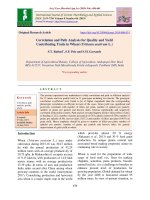
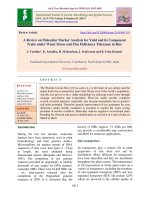
![Studies on correlation and path analysis for grain yield and quality components in foxtail millet [Setaria italica (L.) Beauv.]](https://media.store123doc.com/images/document/2020_01/09/medium_dyd1578574836.jpg)

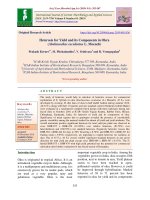
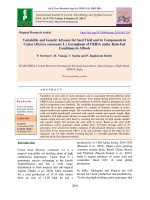
![M1 Biological Injuries: Indicators for M2 macro - and micro-mutation in mungbean [Vigna radiata (L.) Wilczek]](https://media.store123doc.com/images/document/2020_03/11/medium_ixe1583900295.jpg)
